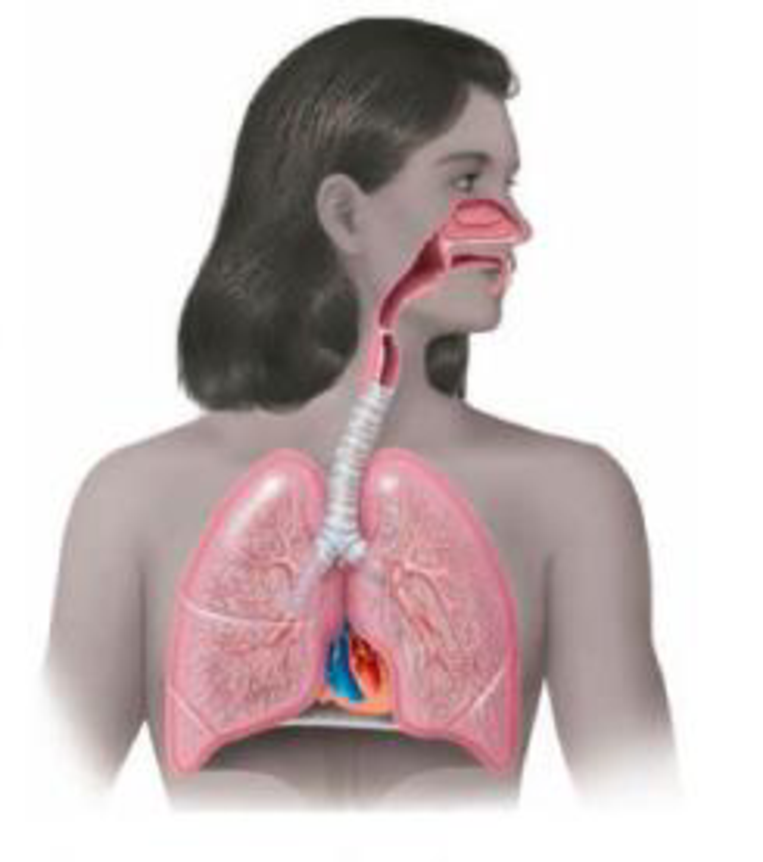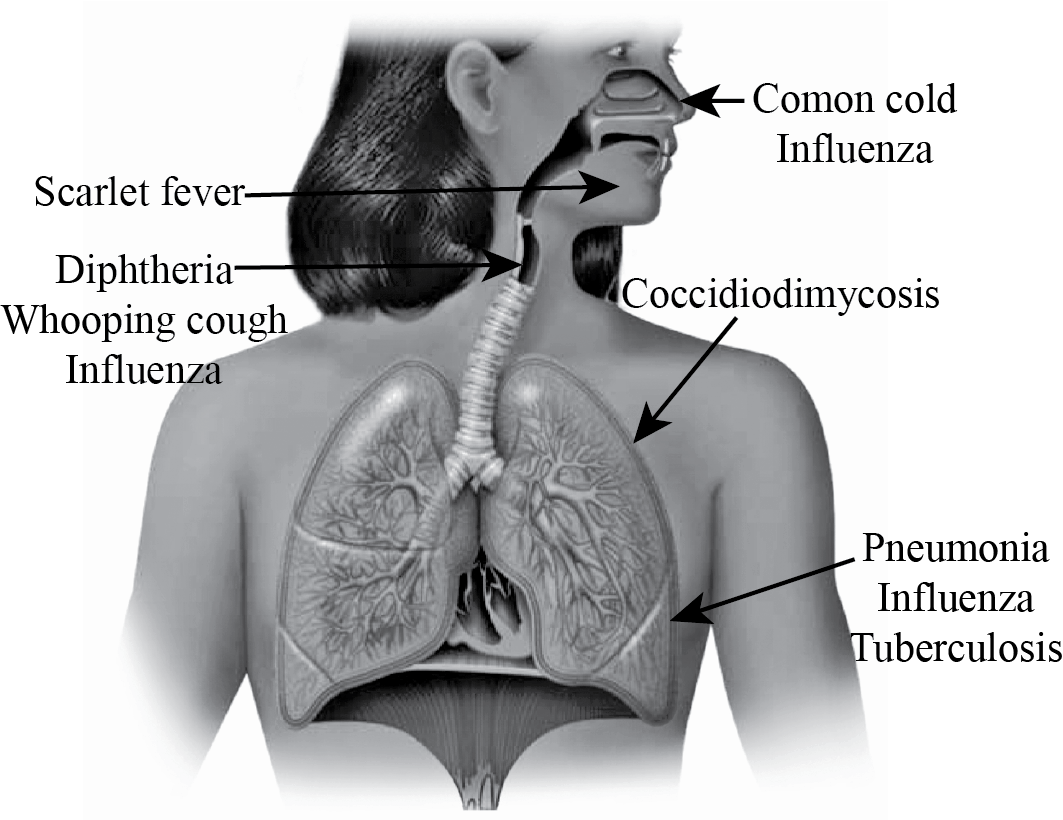
DRAW IT Show the locations of the following diseases: common cold, diphtheria, coccidioidomycosis, influenza, pneumonia, scarlet fever, tuberculosis, whooping cough

To determine:
The location of following diseases of common cold, diphtheria, coccidioidomycosis, influenza, pneumonia, scarlet fever, tuberculosis and whooping cough.
Concept introduction:
Respiratory system consists of two parts, lower and upper parts. Bacteria and virus affects both the parts but lower parts may affects highly than upper parts.
Explanation of Solution
Diagram:
Diseases of Respiratory system

Respiratory system causes diseases which are affected by both bacteria and virus. The upper part causes disease like common cold, diphtheria and whooping cough. Common cold is a viral infection of the upper respiratory system. It is caused by rhinovirus and coronavirus. Scarlet fever caused by streptococcal exotoxin, affects the skin by reddening of tongue and peeling of affected skin. Diphtheria caused by Corynebacterium diphtheria, causes sore throat and swelling of neck. Whooping cough is another disease caused by Bordetella pertussis, tracheal cytotoxin. It affects the cilia and damages the respiratory passages.
Pneumonia causes lower respiratory infection and leads to same symptoms as cold, cough, headache and fatigue and so forth. Pneumonia is the disease of the lower respiratory system. Influenza is characterized by fever, chills, muscular aches and headache. Mycobacterium tuberculosis is a gram positive, rod and an obligate aerobe that causes tuberculosis. It is also a lower respiratory infection.
Many virus can enter into our respiratory system although there is a constant inhibition of pathogens by cilia and mucous membrane. Mostly the upper part is affected but only the lower part is affected by virus infection.
Want to see more full solutions like this?
Chapter 24 Solutions
Microbiology: An Introduction (13th Edition)
Additional Science Textbook Solutions
Campbell Biology (11th Edition)
Genetics: Analysis and Principles
Anatomy & Physiology: The Unity of Form and Function
Campbell Biology (10th Edition)
Human Biology: Concepts and Current Issues (8th Edition)
- Which bacteria are usually to blame for acute endocarditis? Strep pyogenes Staph epidermidis Staph aureusarrow_forwardDescribe each of the following infections using correct technicalterminology. (Descriptions may fit more than one category.) Useterms such as primary, secondary, nosocomial, STD, mixed, latent,toxemia, chronic, zoonotic, asymptomatic, local, systemic, -itis, -emia.Caused by needlestick in dental officePneumocystis pneumonia in AIDS patientBubonic plague from rat flea biteDiphtheriaUndiagnosed chlamydiosisAcute necrotizing gingivitisSyphilis of long durationLarge numbers of gram-negative rods in the bloodA boil on the back of the neckAn inflammation of the meningesarrow_forwardShow a diagram showing the process of Mycobacterium tuberculosis on a cellular levelarrow_forward
- The parents of a 3-day-old male neonate are concerned by their child's condition. The child is irritable, has fever and blisters over most of his body, and peeling skin as seen in the attached image. Which of the following virulence factors produced by the most likely causal agent is responsible for this condition? Answers A - E A Alpha-Toxin B Beta hemolysin C Exfoliative toxin D Pyrogenic exotoxin E Toxic shock syndrome toxin O Question #6 attachment O .0arrow_forwardDiscuss the portal of exit of Mycobacterium tuberculosis from the human body or explain why there is not a portal of exitarrow_forwardPictures of three types of vaginitis are seen below. What the clinician or lab finds is also shown. Specify answers in the correct order. A Prevention Training Center Source: University of Washingt B B O yeast, trich, nonspecific vaginitis mold, yeast, gonorrhea O trich, yeast, chlamydia O yeast, giardia, nonspecific vaginitisarrow_forward
- Explain why people in certain occupations are at increased risk ofbecoming infected with Erysipelothrix rhusiopathiae.arrow_forwardAssuming you have been posted to a community where malaria is very endemic. There is a high rate of absenteeism among your students due to incidents of malaria. As part of your community engagement explain how you would educate on malaria prevention taking the following into consideration:a) Name of the vector and the species of the parasite that cause the diseases in Africa; b) Two chemical and two biological ways of reducing the population of mosquitoes; c) Two in-house measures to prevent mosquitoes bite;d) The stages in the life cycle of the mosquito;e) The names of three African countries that participated in the trial of malarial vaccine.arrow_forwardPlease describe the following communicable disease; and identify the world regions where these diseases are/were most prevalent? And what is /was the global burden for these diseases Ebola Zika TB Influenza Hepatitisarrow_forward
 Comprehensive Medical Assisting: Administrative a...NursingISBN:9781305964792Author:Wilburta Q. Lindh, Carol D. Tamparo, Barbara M. Dahl, Julie Morris, Cindy CorreaPublisher:Cengage Learning
Comprehensive Medical Assisting: Administrative a...NursingISBN:9781305964792Author:Wilburta Q. Lindh, Carol D. Tamparo, Barbara M. Dahl, Julie Morris, Cindy CorreaPublisher:Cengage Learning Medical Terminology for Health Professions, Spira...Health & NutritionISBN:9781305634350Author:Ann Ehrlich, Carol L. Schroeder, Laura Ehrlich, Katrina A. SchroederPublisher:Cengage Learning
Medical Terminology for Health Professions, Spira...Health & NutritionISBN:9781305634350Author:Ann Ehrlich, Carol L. Schroeder, Laura Ehrlich, Katrina A. SchroederPublisher:Cengage Learning Microbiology for Surgical Technologists (MindTap ...BiologyISBN:9781111306663Author:Margaret Rodriguez, Paul PricePublisher:Cengage Learning
Microbiology for Surgical Technologists (MindTap ...BiologyISBN:9781111306663Author:Margaret Rodriguez, Paul PricePublisher:Cengage Learning





